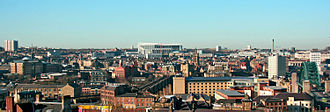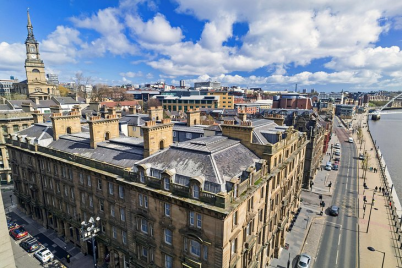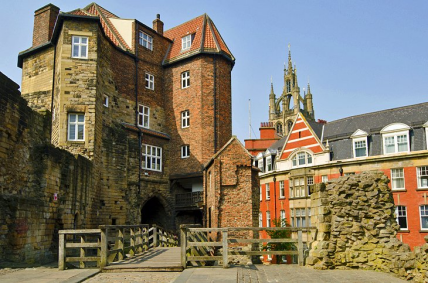Newcastle upon Tyne, Tyne and Wear, England, UK 作者: 来源: 发布时间:2021-03-31
I. Population and Area
Continent: Europe
Country: The U.K
State/Province: England
City/Town: Newcastle upon Tyne, Tyne and Wear
Total Area: 44.02 (sq mi)
Population in 2011: 268.1(thousand)

II. Natural Geography (environment and resources)
Newcastle is situated in the North East of England, in the metropolitan county of yne and Wear and the historical and traditional county of Northumberland. The city is located on the northwestern bank of the River Tyne. It is 46 miles (74 km) from the Scottish border, south of Southdean.

The ground beneath the city is formed from Carboniferous strata of the Middle Pennine Coal Measures Group—a suite of sandstones, mudstones and coal seams which generally dip moderately eastwards. To the west of the city are the Upper Pennine Coal Measures and further west again the sandstones and mudstones of the Stainmore Formation, the local equivalent of the Millstone Grit.
Airport
Newcastle Airport is located approximately 6 miles (9.7 km) from the city centre on the northern outskirts of the city near Ponteland and is the larger of the two main airports serving the North East. It is connected to the city via the Tyne & Wear Metro system and a journey into Newcastle city centre takes approximately 20 minutes. The airport handles over five million passengers per year, and is the tenth largest, and the fastest growing regional airport in the UK,[257] expecting to reach 10 million passengers by 2016, and 15 million by 2030.[258] As of 2007, over 90 destinations are available worldwide.[259]
Rail
Newcastle railway station, also known as Newcastle Central station, is a principal stop on the East Coast Main Line and Cross Country Route. Newcastle station is one of the busiest stations in Britain. Train operator London North Eastern Railway[263] provides a half-hourly frequency of trains to London King's Cross, with a journey time of about three hours, and north to Scotland with all trains calling at Edinburgh Waverley and a small number of trains extended to Glasgow Central, Aberdeen and Inverness.[264] CrossCountry trains serve destinations in Yorkshire, the Midlands and the South West. TransPennine Express operates services to Manchester Airport and Liverpool Lime Street. Northern provides local and regional services
Metro
Haymarket Metro station in Newcastle city centre
The city is served by the Tyne & Wear Metro, a system of suburban and underground railways covering much of Tyne & Wear. It was opened in five phases between 1980 and 1984, and was Britain's first urban light rail transit system; two extensions were opened in 1991 and 2002.It was developed from a combination of existing and newly built tracks and stations, with deep-level tunnels constructed through Newcastle city centre. A bridge was built across the Tyne, between Newcastle and Gateshead, and opened by Queen Elizabeth II in 1981. The network, operated directly by Nexus, carries over 37 million passengers a year, extending as far as Newcastle Airport, Tynemouth, South Shields and South Hylton in Sunderland. In 2004, the company Marconi designed and constructed the mobile radio system to the underground Metro system. The Metro system was the first in the UK to have mobile phone antennae installed in the tunnels.
The Metro consists of two lines. The Green line starts at Newcastle Airport, goes through the city centre and into Sunderland, terminating at South Hylton. The yellow line starts at St James, runs north of the river alongside Byker towards Whitley Bay, before returning to the city, on to Gateshead Interchange and terminates at South Shields.
III.ECONOMY
Newcastle played a major role during the 19th-century Industrial Revolution, and was a leading centre for coal mining, shipbuilding, engineering, munitions and manufacturing. Heavy industries in Newcastle declined in the second half of the 20th century; with office, service and retail employment now becoming the city's staples. The city was recognised for its commitment to environmental issues, with a programme planned for Newcastle to become "the first Carbon Neutral town" however those plans have slipped considerably and they now hope to be carbon neutral by 2050.

Reference Website:
IV. Industrial Characterisitics
Major industries:By 1800 Newcastle had become an important industrial and financial centre (the first banking houses dating from 1755), with expanding ironworking and glassmaking industries. The River Tyne became a major focus for shipbuilding, and Newcastle's shipyards were long among the largest ship-repairing centres in the world.
Big project:Bjarke Ingels Group
Details: Bjarke Ingels Group has unveiled proposals for a 12-storey office block in Newcastle.
The sinuous building, dominating a historic area near the quayside, would be the architect’s first UK building outside London.
BIG opened an office in the capital four years ago on the back of Google’s European headquarters which it is designing with Thomas Heatherwick.
V. Attractions
1. The Tyne Bridges:

Seven bridges span the River Tyne in and around Newcastle, three of them famous internationally for the revolutionary approach to bridge building that they enshrined.
2. Historic Quayside:

The Quayside district around the Tyne and High Level Bridges has been redeveloped, and many of the old houses are now hotels, shops, and restaurants. On Sandhill, a number of historic buildings can be seen, including the Guildhall, built in 1658, and the Merchants' Court. The lovingly restored Bessie Surtees House consists of two merchant's houses dating from the 16th and 17th centuries with a restored Jacobean facade.
3. Newcastle Castle:

North of Newcastle's High Level Bridge on St. Nicholas Street, the well-preserved Norman fortified tower bears testimony to the "New Castle" begun in 1080 and completed in 1172. The late Norman Chapel and the King's Chamber can be visited as you explore the castle's many old passages and medieval chambers. Along the way, you'll find fascinating displays of archaeological artifacts, while the tower offers excellent views over the city.
Reference Website:
https://www.planetware.com/tourist-attractions-/newcastle-upon-tyne-eng-tw-nut.htm
VI. History
The first recorded settlement in what is now Newcastle was Pons Aelius ("Hadrian's bridge"), a Roman fort and bridge across the River Tyne. It was given the family name of the Roman Emperor Hadrian, who founded it in the 2nd century AD. This rare honour suggests Hadrian may have visited the site and instituted the bridge on his tour of Britain. The population of Pons Aelius then is estimated at 2,000. Fragments of Hadrian's Wall are visible in parts of Newcastle, particularly along the West Road. The course of the "Roman Wall" can be traced eastwards to the Segedunum Roman fort in Wallsend—the "wall's end"—and to the supply fort Arbeia in South Shields.
The extent of Hadrian's Wall was 73 miles (117 km), spanning the width of Britain; the Wall incorporated the Vallum, a large rearward ditch with parallel mounds,[20] and was built primarily for defence, to prevent unwanted immigration and the incursion of Pictish tribes from the north, not as a fighting line for a major invasion
VII. Culture
Nightlife
The Gate complex is a nightlife destination in the city with a cinema, restaurants and bars
Newcastle was in the top ten of the country's top night spots, and The Rough Guide to Britain placed Newcastle upon Tyne's nightlife as Great Britain's no. 1 tourist attraction. In the Tripadvisor Travellers' Choice Destination Awards for European Nightlife destinations, four of the UK's nightspots finished in the top 10; Newcastle was awarded 3rd Place behind London, and Berlin. Newcastle also came in seventh for the World category, and is confirmed to have the most events per student population in the UK.
There are concentrations of pubs, bars and nightclubs around the Bigg Market and the Quayside area of the city centre. There are many bars on the Bigg Market, and other areas for nightlife are Collingwood Street, popularly referred to as the 'Diamond Strip' due to its concentration of high-end bars, Neville Street, the Newcastle station area, Osborne Road in the Jesmond area and the Ouseburn Valley area of the city. In recent years "The Gate" has opened in the city centre, a new indoor complex consisting of bars, clubs, restaurants and a 12-screen Cineworld multiplex cinema. Newcastle's gay scene – 'The Pink Triangle' – is centred on the Times Square area near the Centre for Life and has a range of bars, cafés and clubs, such as Powerhouse.

Big Market
The city has a wide variety of restaurants such as Italian, Indian, Persian, Japanese, Greek, Mexican, Spanish, American, Polish, Malaysian, French, Mongolian, Moroccan, Thai, Vietnamese and Lebanese. Newcastle is one of 7 cities in the UK that has a Chinatown with many Chinese restaurants on Stowell Street. There has also been a growth in premium restaurants in recent years with top chefs.
VIII. Other information
Charles Avison, the leading British composer of concertos in the 18th century, was born in Newcastle upon Tyne in 1709 and died there in 1770. Basil Hume, Archbishop of Westminster, was born in the city in 1923. Vice Admiral Cuthbert Collingwood, 1st Baron Collingwood, was born in the city. Ironmaster, metallurgist, and member of parliament Isaac Lowthian Bell was born in the city in 1816. Other notable people born in or associated with Newcastle include: engineer and industrialist Lord Armstrong, engineer and father of the modern steam railways George Stephenson, his son, also an engineer, Robert Stephenson, engineer and inventor of the steam turbine Sir Charles Parsons, inventor of the incandescent light bulb Sir Joseph Swan, actor and comedian Rowan Atkinson, industrial designer Sir Jonathan Ive, who studied at Newcastle Polytechnic (now Northumbria University), modernist poet Basil Bunting, and Lord Chief Justice Peter Taylor. Portuguese writer Eça de Queiroz was a diplomat in Newcastle from late 1874 until April 1879—his most productive literary period. Former Prime Minister of Thailand Abhisit Vejjajiva, was born in the city. Composer Agustín Fernández has been based in the city since 1995, teaching at Newcastle University and occasionally collaborating with Royal Northern Sinfonia.
Musicians Cheryl, Eric Burdon, Sting, Mark Knopfler, the Lighthouse Family, Jeffrey Dunn, Brian Johnson, Alan Hull, Sakima, and Neil Tennant lived in Newcastle. Hank Marvin and Bruce Welch were both former pupils of Rutherford Grammar School. Actors Charlie Hunnam and James Scott, entertainers Ant & Dec and footballers Michael Carrick and Alan Shearer were also born in Newcastle. Multiple circumnavigator David Scott Cowper, Nobel Prize winning physicist Peter Higgs, who researched the mass of subatomic particles, and wrestler Neville were born in the city. John Dunn, inventor of the keyed Northumbrian smallpipes, lived and worked in the city. Kathryn Tickell OBE, the celebrated Northumbrian piper and composer, has longstanding associations with Newcastle as a resident, frequent performer at Sage Gateshead and teacher at Newcastle University. Marc Smith (born 1963), French palaeographer, was born in Newcastle.
IX. Contact information
Mayor/Officer: David Cook
Tel: 0191 278 7878.
Mail:yhn@yhn.org.uk
